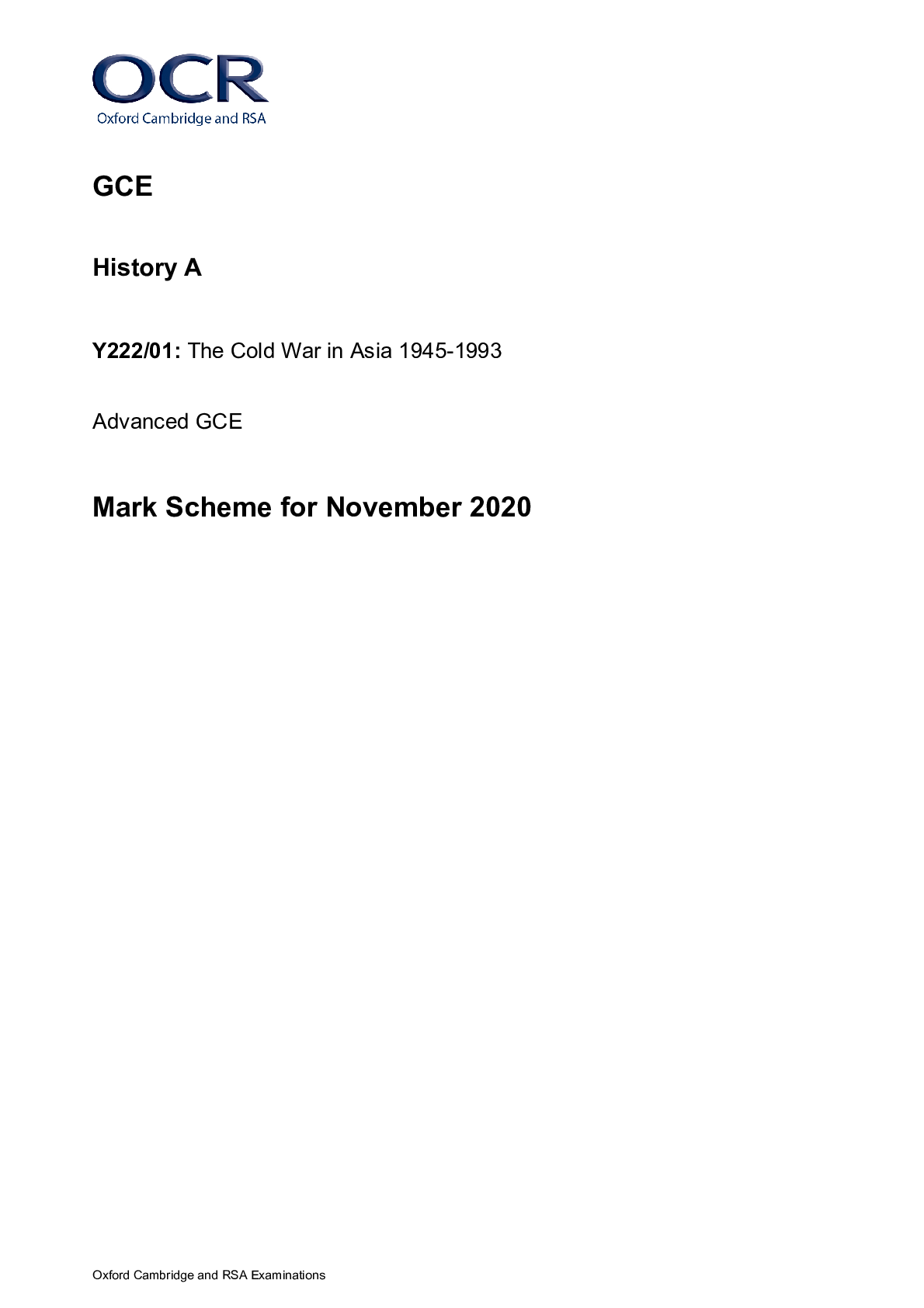English Language > AS Mark Scheme > GCE English Language H470/02: Dimensions of linguistic variation Advanced GCE Mark Scheme for Novemb (All)
GCE English Language H470/02: Dimensions of linguistic variation Advanced GCE Mark Scheme for November 2020
Document Content and Description Below
Oxford Cambridge and RSA Examinations GCE English Language H470/02: Dimensions of linguistic variation Advanced GCE Mark Scheme for November 2020Oxford Cambridge and RSA Examinations OCR (Oxford... Cambridge and RSA) is a leading UK awarding body, providing a wide range of qualifications to meet the needs of candidates of all ages and abilities. OCR qualifications include AS/A Levels, Diplomas, GCSEs, Cambridge Nationals, Cambridge Technicals, Functional Skills, Key Skills, Entry Level qualifications, NVQs and vocational qualifications in areas such as IT, business, languages, teaching/training, administration and secretarial skills. It is also responsible for developing new specifications to meet national requirements and the needs of students and teachers. OCR is a not-for-profit organisation; any surplus made is invested back into the establishment to help towards the development of qualifications and support, which keep pace with the changing needs of today’s society. This mark scheme is published as an aid to teachers and students, to indicate the requirements of the examination. It shows the basis on which marks were awarded by examiners. It does not indicate the details of the discussions which took place at an examiners’ meeting before marking commenced. All examiners are instructed that alternative correct answers and unexpected approaches in candidates’ scripts must be given marks that fairly reflect the relevant knowledge and skills demonstrated. Mark schemes should be read in conjunction with the published question papers and the report on the examination. © OCR 2020H470/02 Mark Scheme November 2020 4 Annotations Annotation Meaning Blank Page – this annotation must be used on all blank pages within an answer booklet (structured or unstructured) and on each page of an additional object where there is no candidate response. Positive Recognition Assessment Objective 1 Assessment Objective 2 Assessment Objective 3 Assessment Objective 4 Attempted or insecure Irrelevant Tick V VagueH470/02 Mark Scheme November 2020 5 INTRODUCTION Your first task as an Examiner is to become thoroughly familiar with the material on which the examination depends. This material includes: • the specification, especially the assessment objectives • the question paper and its rubrics • the texts which candidates have studied • the mark scheme. You should ensure that you have copies of these materials. You should ensure also that you are familiar with the administrative procedures related to the marking process. These are set out in the OCR booklet Instructions for Examiners. Please ask for help or guidance whenever you need it. Your first point of contact is your Team Leader.H470/02 Mark Scheme November 2020 5 These are the Assessment Objectives for the English Language specification as a whole. AO1 Apply appropriate methods of language analysis, using associated terminology and coherent written expression. AO2 Demonstrate critical understanding of concepts and issues relevant to language use. AO3 Analyse and evaluate how contextual factors and language features are associated with the construction of meaning. AO4 Explore connections across texts, informed by linguistic concepts and methods. AO5 Demonstrate expertise and creativity in the use of English to communicate in different ways. WEIGHTING OF ASSESSMENT OBJECTIVES The relationship between the components and the assessment objectives of the scheme of assessment is shown in the following table: Component % of A level AO1 AO2 AO3 AO4 AO5 Total Exploring language H470/01 11% 6% 11% 6% 6% 40% Dimensions of linguistic variation H470/02 11% 11% 12% 6% 0% 40% Independent language research H470/03 5% 5% 5% 0% 5% 20% 27% 22% 28% 12% 11% 100%H470/02 Mark Scheme November 2020 6 USING THE MARK SCHEME Study this Mark Scheme carefully. The Mark Scheme is an integral part of the process that begins with the setting of the question paper and ends with the awarding of grades. Question Papers and Mark Schemes are developed in association with each other so that issues of differentiation and positive achievement can be addressed from the very start. This Mark Scheme is a working document; it is not exhaustive; it does not provide ‘correct’ answers. The Mark Scheme can only provide ‘best guesses’ about how the question will work out, and it is subject to revision after we have looked at a wide range of scripts. The Examiners’ Standardisation Meeting will ensure that the Mark Scheme covers the range of candidates’ responses to the questions, and that all Examiners understand and apply the Mark Scheme in the same way. The Mark Scheme will be discussed and amended at the meeting, and administrative procedures will be confirmed. Co-ordination scripts will be issued at the meeting to exemplify aspects of candidates’ responses and achievements; the co-ordination scripts then become part of this Mark Scheme. Before the Standardisation Meeting, you should read and mark in pencil a number of scripts, in order to gain an impression of the range of responses and achievement that may be expected. In your marking, you will encounter valid responses which are not covered by the Mark Scheme: these responses must be credited. You will encounter answers which fall outside the ‘target range’ of Bands for the paper which you are marking. Please mark these answers according to the marking criteria. Please read carefully all the scripts in your allocation and make every effort to look positively for achievement throughout the ability range. Always be prepared to use the full range of marks.H470/02 Mark Scheme November 2020 7 PAPER-SPECIFIC INSTRUCTIONS: H470/02 Dimensions of linguistic variation Candidates answer all the questions on the paper. The paper addresses assessment objectives 1-4: Assessment Objectives AO1 and AO2 are addressed in question 1. Assessment Objectives AO2 and AO3 are addressed in question 2. Assessment Objectives AO1, AO3 and AO4 are addressed in question 3. AO5 is assessed in components 1 and 3. In each question, the assessment objectives are given equal weighting. THE INDICATIVE CONTENT FOR EACH TASK provides an indication of what candidates are likely to cover. The notes are neither prescriptive nor exhaustive: candidates should be rewarded for any relevant response which appropriately addresses the Assessment Objectives. THE LEVEL DESCRIPTORS FOR EACH QUESTION FOLLOW THE INDICATIVE CONTENT SUBJECT-SPECIFIC INSTRUCTIONS: ENGLISH LANGUAGE • Each level descriptor covers the relevant assessment objectives. • Where the assessment objectives appear in separate columns, marks should be allocated for each assessment objective independently of one another. There is no requirement for responses to be allocated marks from within the same level across each assessment objective. • An answer does not have to meet all the requirements of a level descriptor before being placed in that level. The extent to which it meets all of the requirements of a level descriptor will determine its placement within that level. • The extent to which the statements within the level have been achieved should be the only criteria used when deciding the mark within a level. • Indicative content indicates possible points candidates might make, but this is not an exhaustive account. Any valid response should be rewarded.H470/02 Mark Scheme November 2020 8 Indicative Content - Please note: indicative content indicates possible points candidates might make, but this is not an exhaustive account. Any valid response should be rewarded. Question Guidance Marks Text features 1 Text A is a transcript from a private data source. Maisie (aged three years) and Chloe (aged three years and four months) are making models. Chloe’s mother, Anna, is also present. Using the appropriate terminology to explain your findings, examine the language development stage of the child-participants as evidenced in the transcript. You should identify and analyse the phonology, grammar and meaning of their utterances. Use your knowledge of theories and concepts of child language acquisition to support your answer. Meaning: • Both children use labelling correctly, ‘forest’, ‘creatures’, ‘orange’. • Maisie initiates and directs the play throughout; Chloe is more collaborative in her approach, asking Maisie a question ‘what colours do your mummy and daddy like (.) Maisie’. • Frequent references to parents/parental approval ‘daddy will like all these colours that I doing’. 20 Phonology: • Maisie repeats the phrase ‘too many’ several times, referring to the sweets and to the creatures, sometimes emphasising the intensifier ‘too’. • The children repeat each other’s structures: ‘do you want to see what I’m making’/‘mummy do you know what I’m making’. • Both children use largely standard pronunciation with one exception each: ‘need lotθ/ [ lots]’ (Chloe) – candidates may speculate that this is addition or a lisp – and ‘like /lelləυ/ [yellow]’ (Maisie) – substitution/assimilation. • Use of diminutives ‘sweeties’. Grammar: • Both children make use of interrogatives, ‘mummy do you know what I’m making’/‘do you want to see what I’m making’. • Maisie uses a number of imperatives, including negative imperatives, ‘don’t have too many’. This could be explored in the wider context of her relative confidence in taking the lead (considering she is the slightly younger of the two, and they are with Chloe’s mother rather than hers) and her use of CDS. • Chloe omits the auxiliary sometimes, ‘I making lots of creatures’, and uses it sometimes, ‘what I’m making’. • Fairly limited range of verb choices e.g. ‘having’, ‘making’ ‘know’, ‘like’. • Some use of concrete nouns – ‘caterpillar’, ‘sweeties’, ‘forest’ – reflecting topic/activity. • Chloe uses the present progressive ‘I’m making’ (could link to Brown/acquisition of the -ing morpheme) as well as theH470/02 Mark Scheme November 2020 9 present simple ‘I needlotθ [ lots]’ and future simple ‘my daddy will like it’. • Maisie uses standard syntax (e.g. subject-verbcomplement) appropriately ‘this is for my mummy and daddy’, including accurate pronoun use. There may be specific relevant comment on Anna’s interventions; these should be rewarded (although the focus needs to remain with the children participants). For example: • Anna uses a mixture of interrogatives and minor sentences (‘what’s that’, ‘oh cool’) to support the children and provide scaffolding. The latter resists convergence, to some extent, and provides model based on own idiolect/style. • The children both appeal to Anna for her opinion and require input from her ‘d’you want (.) Anna (.) do you want to see what I’m making’. • Maisie uses speaker nomination (see above) to ensure she elicits a response. • Anna offers praise in the form of the empty adjective (Lakoff) ‘lovely’. Question Guidance Marks Text features 1 Concepts: • Maisie uses regulatory functions – Halliday – ‘don’t have too many’. • Chloe’s non-standard pronunciation in her utterance, ‘I need / lotθ [ lots]’ and nonstandard grammar ‘I making’, would not have been copied (supports Chomsky). • Anna’s interaction provides scaffolding (Bruner) and positive attention/ encouragement, ‘oh cool’/‘lovely’ (Skinner). 20 • Many of the utterances include or revolve around objects – sweets/forests/creatures – supporting Nelson’s findings that nouns/naming words represent 60% of children’s early word production. • Chloe’s accurate understanding of the relationship between ‘forest’ and ‘creatures’ suggests some grasp of network-building and hypernyms/hyponyms (Aitchison).H470/02 Mark Scheme November 2020 10 There are a total of 20 marks available for Question 1. Decide on a mark for AO1 out of 10, and then a separate mark for AO2 out of 10. Add the two marks together to reach a total out of 20 marks. It is possible that candidates may achieve different bands for each AO: allocate the mark according to the level of competency demonstrated for each AO individually. Level AO1 Mark AO2 Mark 5 • The response will make assured reference to a wide range of language features, with appropriate and well-selected examples which support a focussed analysis. • The response will be enhanced by consistently accurate use of a wide range of appropriate terminology; writing is in a secure academic register. 9–10 • The response will make assured reference to stages of development explained and explored effectively, with well-selected examples. • The response will make discerning/perceptive links to theory or concepts in a way that suggests assured understanding of the relationship between theory and practice. 9–10 4 • The response will make consistently accurate reference to a range of language features, with appropriate examples and developed analyses. • The response will make consistently accurate use of a range of appropriate terminology to enhance the response; written expression is coherent. 7–8 • The response will make consistently accurate reference to stages of development with appropriate examples and an analysis which demonstrates awareness of the complexity of the processes involved. • The response will consistently connect the elements of the participants’ language usage with a variety of concepts/ theories in a way that suggests secure understanding of the relationship between theory and practice. 7–8 3 • The response will make generally accurate reference to a range of language features, with appropriate examples and a clear attempt at analysis. • Accurate use of appropriate terminology will enhance the response; written expression is clear. 5–6 • The response will make generally accurate reference to stages of development, with appropriate examples and supporting comment or explanation. • The response will connect the elements of the participants’ language usage with concepts and theories in a way that is valid and relevant. 5–6H470/02 Mark Scheme November 2020 11 Level AO1 Mark AO2 Mark 2 • The response will identify some relevant language features, with appropriate examples and relevant comments. • Appropriate terminology will be used accurately, although the range of terminology will be limited; written expression has some errors but the meaning remains apparent. 3–4 • The response will make some accurate reference/s to stages of development, with some relevant comments or appropriate examples. • The response will make valid connections between elements of the participants’ language usage and concepts or theory. 3–4 1 • The response will identify features of the material, but will make very few relevant or valid points about these features in relation to the question. • Little or no accurate use of appropriate terminology; writing may at times obscure meaning. 1–2 • The response will make little or basic reference to stages of language development. • Few if any valid links between elements of participants’ language and appropriate stage/s of development or other relevant concepts. 1–2 0 • No response or no response worthy of any credit. 0 • No response or no response worthy of any credit. 0H470/02 Mark Scheme November 2020 12 Indicative Content - Please note: indicative content indicates possible points candidates might make, but this is not an exhaustive account. Any valid response should be rewarded. Question Guidance Marks Text features 2 Text B is an edited extract from an online article posted on the ‘List 25’ website on October 19th 2016. Using your understanding of relevant ideas and concepts, investigate how language features and contextual factors construct meanings in this text. Possibilities are provided below for guidance but any valid response should be rewarded. This online article contains characteristic features of multi-modal texts. The website it appears on specialises in producing lists of twenty-five items – in this case twenty-five ‘Superpowers you wish you had’ – so follows an established format. The text raises issues about power in a humorous way and makes a number of references to popular culture. As well as being explicitly about physical (albeit imagined) manifestations of power, it also references power more obliquely in its citing of various figures who are perceived as having influential power, all but one of whom are male. The way the writer positions themselves in relation to the reader could be explored as well. 24 Possibilities are provided below for guidance but any valid response should be rewarded. • Starting a paragraph with direct address ‘Admit it – there are superpowers you wish you had. …’ creates conversational tone/sense of ongoing dialogue with reader – typical of genre. Candidates might identify synthetic personalisation/Fairclough; Goodman – informalisation – could also be mentioned ‘the power every little kid dreams of’/colloquial lexis. • Unintentional inaccuracies – ‘you’d know be able to locate’ – deformalisation/crumbling castle argument. • The fact that all but one of the figures mentioned as possessing superpowers are male conforms with gender stereotypes (Pilkington); Tannen (six contrasting pairs/qualities of Status and Conflict particularly reflected as male) could also be mentioned. • Graphological features that are characteristic of genre e.g. reference to ‘shares’. • Lexical fields of control and achievement: ‘upper hand’, ‘mind control’, ‘excellent’, ‘superior intellect’, ‘ace’ [exam], reflecting topic; in line with Tannen. • Power is reflected in the verb choices: ‘persuade’, ‘demand’, brainwash’. • Range of proper nouns/names to establish credibility of views being expressed/influential power (Fairclough). • Range of auxiliary verbs, especially ‘could’, followed by conditionals ‘would’ to illustrate the possibilities specific powers would confer.H470/02 Mark Scheme November 2020 13 Pragmatics: • Mention of figures with instrumental power (Fairclough, and/or Thomas and Wareing) – ‘boss’, ‘professor’ text explores ways in which the reader could manipulate/control them. • Establishes the topic at the beginning and then ‘talks’ the reader through it – could be linked to Grice’s maxim of relevance. • The intensifier adverb ‘really’ in the title suggests that the article is exploring an assumption that readers (or the general public) may hold. • Makes assumptions about shared frames of reference explicit, ‘There’s really no need to introduce this superpower’. • Often equates power with freedom, eg ‘where you could travel anywhere on a whim and see the world from a bird’s eye view’. • Represents power as being desirable and mainly in the possession of men (asymmetry of cultural/intertextual referencing)/reinforces gender stereotypes. • The writer positions themselves as having power over the reader, ‘Admit it – there are superpowers you wish you had’, both grammatically (through use of the imperative) and semantically through the verb choice; it suggests the writer has inside knowledge about the reader’s secret wishes. • The disclaimer starting with the negative imperative, ‘Don’t worry. No judgment here’, may convey the opposite message to the reader, ie that their secret wish for these superpowers is a guilty secret, or, at least, that the writer would potentially be in a position to make judgements. Could also be linked to Goffman/face-saving. • Use of modal auxiliary ‘could’ throughout, in combination with the ongoing conditionals ‘If…’ represent theH470/02 Mark Scheme November 2020 14 possession/acquisition of superpowers as a possibility that can be explored even if it is unlikely to be achieved. • Assumptions are made about fairly broad shared cultural references eg Chuck Norris: (could be linked to Fairclough’s members’ resources). • Use of humour in the premise as well as the wording. Power is represented – albeit humorously – as being linked to success/competitiveness/wealth etc. • Reference to receiving ‘an A from your professor’ suggests American provenance, as does the adjective choice/use ‘You could be as smart as Albert Einstein’. • Assumes grasp of student lifestyle ‘all-nighter’ – presupposes identification with attitude.H470/02 Mark Scheme November 2020 15 There are a total of 24 marks available for Question 2 Decide on a mark for AO2 out of 12, and then a separate mark for AO3 out of 12. Add the two marks together to reach a total out of 24 marks. It is possible that candidates may achieve different bands for each AO: allocate the mark according to the level of competency demonstrated for each AO individually. Level AO2 Mark AO3 Mark 6 • Candidates show an assured knowledge and understanding of relevant concepts and issues. • Candidates engage critically with the ways concepts and issues inform their analysis of the text’s patterns of language use. 11–12 • Candidates offer a discerning exploration of a range of contextual factors and language features, and how they are associated with the construction of meaning. • Candidates evaluate in perceptive detail how contextual features inherent in the text are associated with the construction of meaning. 11–12 5 • Candidates show a good knowledge and understanding of relevant concepts and issues. • Candidates use their knowledge and understanding of concepts and issues to offer informed comment of the text’s patterns of language use. 9–10 • Candidates respond in detail to a range of contextual factors and language features, and how they are associated with the construction of meaning. • Candidates will analyse in detail how contextual features inherent in the text are associated with the construction of meaning. 9–10 4 • Candidates show a sound level of knowledge and understanding of relevant concepts and issues. • Candidates use their knowledge and understanding of concepts and issues to comment on some language features in the text. 7–8 • Candidates make a sound attempt to respond to a range of contextual factors and language features, and how they are associated with the construction of meaning. • Candidates make clear, relevant response to the contextual features inherent in the text and how these are associated with the construction of meaning. 7–8 3 • Candidates show a largely accurate knowledge and understanding of language concepts or issues, although is likely to lack the depth needed to be convincing. • Candidates use their knowledge and understanding of concepts and issues to comment generally on language use in the text. 5–6 • Candidates make some attempts to respond to contextual factors and language features and make some points about how they are associated with the construction of meaning. • Candidates make general comments regarding the contextual features inherent in the text, showing some understanding of how these are associated with the construction of meaning. 5–6H470/02 Mark Scheme November 2020 16 Level AO2 Mark AO3 Mark 2 • Candidates’ knowledge and understanding of concepts/issues is likely to have inaccuracies or be muddled. • Candidates use concepts/issues to comment on the text, although connections may be lacking or confused. 3–4 • Candidates make a limited response to contextual factors and language features and how they are associated with the construction of meaning. • Candidates show a basic understanding of how contextual features inherent in the text contribute to the overall meaning. 3–4 1 • Candidates select irrelevant or unconnected concepts or issues, or presents erroneous accounts of concepts. • Candidates attempt to use concepts or issues to the text, although these will be superficial. 1–2 • Candidates make only one or at the most two references to contextual factors and language features and how they are associated with the construction of meaning. • Candidates make little attempt to show understanding of how one or more contextual features inherent in the text contribute to the overall meaning. 1–2 0 • No response or no response worthy of any credit. 0 • No response or no response worthy of any credit. 0H470/02 Mark Scheme November 2020 17 Indicative Content - Please note: indicative content indicates possible points candidates might make, but this is not an exhaustive account. Any valid response should be rewarded. Question Answer Mark Guidance 3 Text C is an extract from a book of letters called ‘The Natural History of Selborne’, by Gilbert White. It was published in 1789. Text D is an extract from a website providing information about the natural history of Woolmer Forest. It was published in 2006. By detailed analysis of the writing in both passages, discuss and illustrate the variations in language between the 18th and 21st centuries. Answers should explore the ways language is used in each text, as well as how contextual factors influence the way meaning is constructed. AO3: Text C’s general contextual features: The text was the opening section of a book of letters in which Gilbert White wrote about the natural history of Selborne to Thomas Pennant. The focus is on the Woolmer Forest, its wildlife and natural features. Although the content is largely factual, the tone is sometimes more personal, as may be expected in a letter. 36 Lexis and semantics Text C Text D • Nature of document – about features of wildlife and landscape – lends itself to multiple concrete nouns: ‘trees’, ‘oak’, ‘bogs’, ‘soil’. • Archaic phrasing ‘in vast plenty’, ‘rather suppose’, and lexis that is not archaic but which is in less common usage now, ‘abounding’/ ‘abutted’/ ‘abounded’, ‘of late’. • Formal register arising partly from Latinate lexis: ‘diversified’, ‘consisted’, ‘procured’, ‘subterraneous’. • Personal tone which may relate to epistemological form created partly through ‘adjective/verb choices: ‘curious’, ‘lonely’, ‘love’, ‘agreeable’. • Semantic shift in the adjective ‘nice’. • Lexical field of nature including some words that border on jargon: ‘subterraneous trees’. • Intensifiers/modifiers used to create greater precision within the description: ‘so much’. ‘so well’, ‘some such’, ‘very’, ‘to such a degree’. • Concrete nouns to refer to the forest and its inmates ‘amphibians and reptiles…rare smooth snake and the Natterjack Toad’, and physical features, ‘rolling hills, heather covered heathland and low lying bogs’. • Lexical field of nature and of nature management, ‘wardenship’, ‘turf cutting', ‘wildlife reserves’, ‘valuable resource’. • Some adjectives are part of the names of different species of wildlife ‘great grey shrike’, ‘smooth snake’; others are used to represent the forest positively, ‘richest heathland wildlife reserves’, ‘long history’. • Field specific lexis relating to forests/wood, ‘dense woodland’, ‘mature oaks’, ‘timber’. • Semantic field of legality/protection ‘guarded’, ‘rights’, ‘indicted’, ‘trespass’.H470/02 Mark Scheme November 2020 18 Grammar and morphology Text C Text D • Clause-laden sentences, for example the first, which uses what would now be seen as the modal ‘should’ as a subjunctive. Subordinate first clauses commonplace at this time and directly comparable with other text. • Frequent use of colons and semi colons to separate main and dependent clauses. • Range of proper nouns reflecting the focus on location ‘Greatham, Lysse, Rogate’. • Largely declarative sentences, mostly complex or complex/compound. • Use of present perfect, ‘Besides the oak, I have also been shown pieces of fossil-wood…’ to explain lead-up to the judgements made. • Complex sentences with embedded clauses typical of the period, ‘snipes, wild-ducks, and, as I have discovered within these few years, teals.’ • Use of first person reflects letter format; tautologous reflexive pronoun asserts author’s opinion ‘But he was mistaken: for I myself…’. • Primary auxiliary/copular verb usage ‘is’/’are’ conveying factual information. • Complex sentences with embedded relative clauses, ‘At about the same time Alice Holt, where nearly 40,000 mature oaks were standing in 1783, up to a thousand loads of timber were felled each year for the use of the navy’. • Use of a mix of dynamic verbs and stative verbs/verb phrases: ‘hunted’, ‘were felled’, ‘form’, ‘stands’. • Combination of past and present tense; the former relating to historical events the latter to the status quo. • Pre-modifying adjectives distinguish species: ‘little hobby hawking dragonflies’, ‘great grey shrike’. • Proper nouns reflect focus on location and the people shaping its history: ‘East Worldham… King John’. • Declarative sentences throughout. • Idiomatic verb phrase ‘passed into the hands’ and noun phrase, ‘on our very doorstep’. • Use of passive voice reflecting incomplete knowledge of historical events: ‘the last of Woolmer Forest’s native trees… were felled “by persons unknown”, ‘three hundred and twenty-five loads of peat and 340,000 turfs were taken’.H470/02 Mark Scheme November 2020 19 • Pre-modifying comparatives to explain conclusions: ‘paler colour, and softer nature’. Question Answer Mark Guidance 3 Text D’s general contextual features: an extract from a website produced by an individual, Tom Muckley, providing information about the natural history of Woolmer Forest. It was published in 2006 and enables the reader to appreciate the contrast between the area’s past and present. While not being overtly persuasive, it does represent the forest in an appealing way. There are a couple of unintentional inaccuracies. AO4: Whilst both texts focus on the Forest of Woolmer at Selborne in general and its natural history in particular, the ways in which it is represented are different, with the earlier text being more personal and related to the writer’s own interactions with the forest and its wood. There is a stronger sense of the individual in Text C; as well as writing in the first person, he refers to his own relationship with the forest explicitly; this reflects his identity as a well-known naturalist. 36 Discourse Text C Text D • Textual cohesion is provided by the letter format – the author establishes at the beginning that he is going to describe the area in detail and then proceeds to do so, qualifying facts and interrogating them as he does so. • The text is divided into paragraphs detailing the nature of different aspects of the forest and its history. • The extract moves between the personal and the general and back again. • The underlying structure is chronological, so that there are references to dates (‘1278’, ‘1578’), and use of time adverbials (‘finally’, ‘today’), and noun phrases relating to time: ‘Dark Ages’, ‘Middle Ages’. • References to historical developments are used as discourse markers at the beginning of paragraphs, ‘With the coming of the Normans’. • There is use of listing, in accordance with text’s informational nature and purpose, and some triadic structures/tripling, ‘the haunt of wolves, swine and deer’. • Having narrated the history of the area, the text returns to the present tense with a rhetorical question at the end: ‘How many of us know that such a valuable resource, with such a long history, stands on our very doorstep?’H470/02 Mark Scheme November 2020 20 Whereas Text C is quite discursive in its approach, Text D is more structured, and is underpinned by a chronological account of the forest’s history and past and present attributes and appeal. Possibilities are provided (right) for guidance but any valid response should be rewarded. Each language level is taken in turn to illuminate the likely connections which may be explored by candidates across both texts. Pragmatics Text C Text D • Positive personification of wildlife through verb choice ‘they love to make excursions’ contrasting with more negative representation of hunters, ‘unreasonable sportsmen’. • Professed aim of describing forest with precision (‘Should I omit to describe with some exactness the forest of Wolmer, of which three-fifths perhaps lie in this parish, my account of Selborne would be very imperfect) is reflected throughout in qualifiers and comparatives • Author draws on his own experience, positioning himself as a ‘sportsman and as a naturalist’; he also conducts experiments and uses his own observation as the basis of contradicting ‘Dr. Plot’, a fellow naturalist. • Emphasis on forest’s royal ownership/connections, ‘royal forest’ and ‘This royalty’. • Superlatives and lexical choices pertaining to rarity represent the forest as unique and special: ‘best known’, ‘one of Britain’s richest heathland wildlife reserves. It is, for example, the only site in’, ‘over 130 different species’. • Emphasis on various events/ historical destruction of parts of the forest and the corresponding endeavours made to protect it: ‘Kings… guarded their rights zealously’, ‘exploitation of the forest for grazing’, ‘Military occupation has prevented conversion to agriculture’. • Direct quotation from historical sources supports authenticity of the account: ‘In 1578 the last of Woolmer Forest’s native trees, at Linchborough, were felled “by persons unknown”’. • Underpinning mixture of facticity with implied support for the forest and its protection.H470/02 Mark Scheme November 2020 21 There are a total of 36 marks available for Question 3. Decide on a mark for AO1 out of 12, and then a separate mark for AO3 out of 12, and a separate mark for AO4 out of 12. Add the three marks together to reach a total out of 36 marks. It is possible that candidates may achieve different bands for each AO: allocate the mark according to the level of competency demonstrated for each AO individually. Level AO1 Mark AO3 Mark AO4 Mark 6 • Candidates apply a wide range of appropriate methods in an assured and systematic way, using appropriate terminology and writing in a secure academic register. • They deftly establish and explore patterns of language use and can closely analyse incisively chosen evidence. 11–12 • Candidates make discerning points about the possible effect of contextual factors on particular features of language, both in terms of production and reception. • They perceptively evaluate their points, suggesting alternatives for how context might account for variations in language use. 11–12 • Candidates selectively and methodically apply confident knowledge of appropriate linguistic concepts across both texts. • Candidates compare particular linguistic features in the two texts, making illuminating connections between them which clearly establish some of the ways that language has varied over time. 11–12 5 • Candidates apply a range of appropriate methods to the texts in a systematic way, using appropriate terminology and coherent written expression. • They establish patterns of language use and can analyse well-chosen evidence in some depth. 9–10 • Candidates make strong and helpful points about relevant contextual factors, showing how context might affect language use, both in terms of production and reception. • They show that they can weigh up how contextual factors might account for variations in language use. 9–10 • Candidates methodically apply sound knowledge of appropriate linguistic concepts across both texts. • Candidates compare linguistic features in the two texts, making helpful connections between them which show some of the ways that 9–10H470/02 Mark Scheme November 2020 22 language has varied over time. Level AO1 Mark AO3 Mark AO4 Mark 4 • Candidates apply some appropriate methods in a sound way, using mostly appropriate terminology and coherent if uneconomical writing. • Analysis is characterised by either a fairly limited number of well-developed points, with relevant evidence, or a larger number of valid supported points that lack depth. 7–8 • Candidates make some valid points about context, showing how contextual factors can affect language production and reception. • They come to some sound conclusions about how contextual factors could cause variations in language. 7–8 • Candidates apply accurate knowledge of linguistic concepts to language features in a way that is mostly appropriate, across both texts. • They make some comparisons of linguistic features in the two texts, making some connections between them which show ways in which language use has varied over time. 7–8 3 • Candidates attempt to apply linguistic methods with some success, and terminology is at times appropriate; written expression contains some errors. • Analysis is uneven and is characterised by either scattered points that are supported with evidence or points which may have validity but are unsupported. 5–6 • Candidates make a few successful attempts at showing how basic contextual factors affect the way language is produced and received. • Conclusions drawn tend to be assertive and simplistic rather than weighed in the balance and are sometimes unconvincing; there may be an elementary sense of how context affects language variation. 5–6 • Candidates have a loose grasp of linguistic concepts and attempt to apply them across both texts, although sometimes unconvincingly. • They will make more general connections and will attempt to compare particular features associated with the ways language use has varied over time, but with only partial success. 5–6H470/02 Mark Scheme November 2020 23 Level AO1 Mark AO3 Mark AO4 Mark 2 • Candidates make a vague attempt to apply linguistic methods to the texts and some terms are used, with occasional appropriateness; writing is likely to contain errors which sometimes obscure meaning. • One or two simple points are made, with little or tenuous evidence; assertive rather than analytical. 3–4 • Candidates can comment on context, although this is unlikely to show proper grasp of production and reception and so is of very limited use. • Evaluation of points is not happening in this band because there is no real exploration of language, but there may be one or two generalisations made about the effects of context on the language. 3–4 • Where linguistic concepts are in evidence for each text, understanding is shallow and knowledge of them is likely to be muddled. • Some loose connections between the texts are established in one or two places in the answer. These connections are likely to be simple matching or contrasting of features with very little demonstration of how language use has varied over time. 3–4 1 • Candidates struggle to apply the linguistic methods; terminology, if present, is inappropriate and accuracy of written expression is very limited. • There may be the odd point made but there is no analysis with evidence. 1–2 • One or at the most two references are made to the context with no link to language production or reception. • Little or no attempt to draw conclusions about the effect of context on different uses of language. 1–2 • Any knowledge of linguistic concepts is likely to be mostly inaccurate with perhaps a very vague sense of understanding both texts being present. • The notion of comparison is essentially lost in this band. There may be one or two connections here and there but these do not help with notions of how language use has varied over time. 1–2 0 • No response or no response worthy of any credit. 0 • No response or no response worthy of any credit. 0 • No response or no response worthy of any credit. 0H470/02 Mark Scheme November 2020 24 APPENDIX 1 Assessment Objective weightings are given as percentages. Assessment Objectives Grid Question AO1% AO2% AO3% AO4% AO5% Total% 1 5 5 0 0 0 10 2 0 6 6 0 0 12 3 6 0 6 6 0 18 Totals 11% 11% 12% 6% 0% 40%OCR (Oxford Cambridge and RSA Examinations) The Triangle Building Shaftesbury Road Cambridge CB2 8EA [Show More]
Last updated: 1 year ago
Preview 1 out of 25 pages
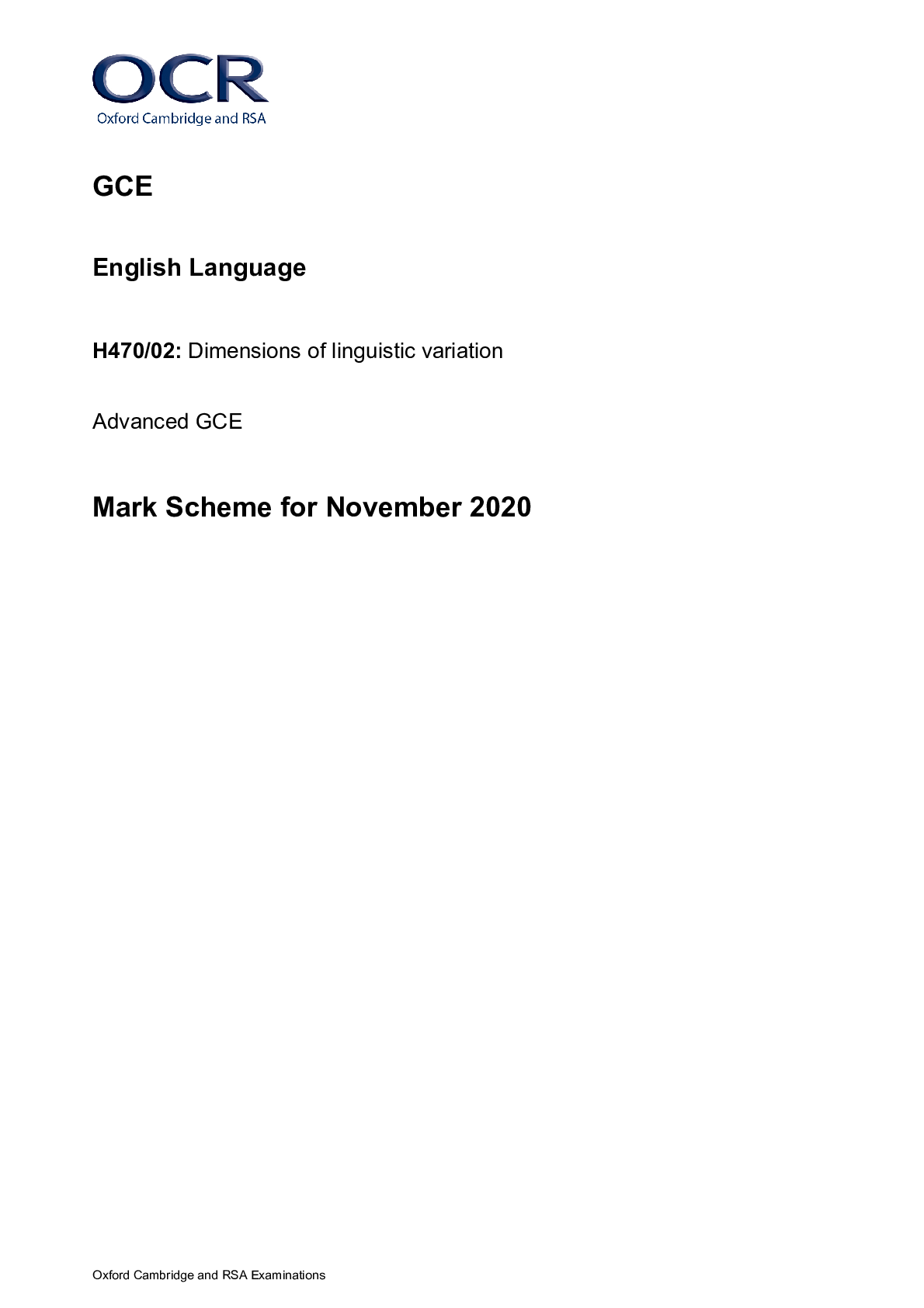
Reviews( 0 )
Document information
Connected school, study & course
About the document
Uploaded On
Oct 10, 2022
Number of pages
25
Written in
Additional information
This document has been written for:
Uploaded
Oct 10, 2022
Downloads
0
Views
56








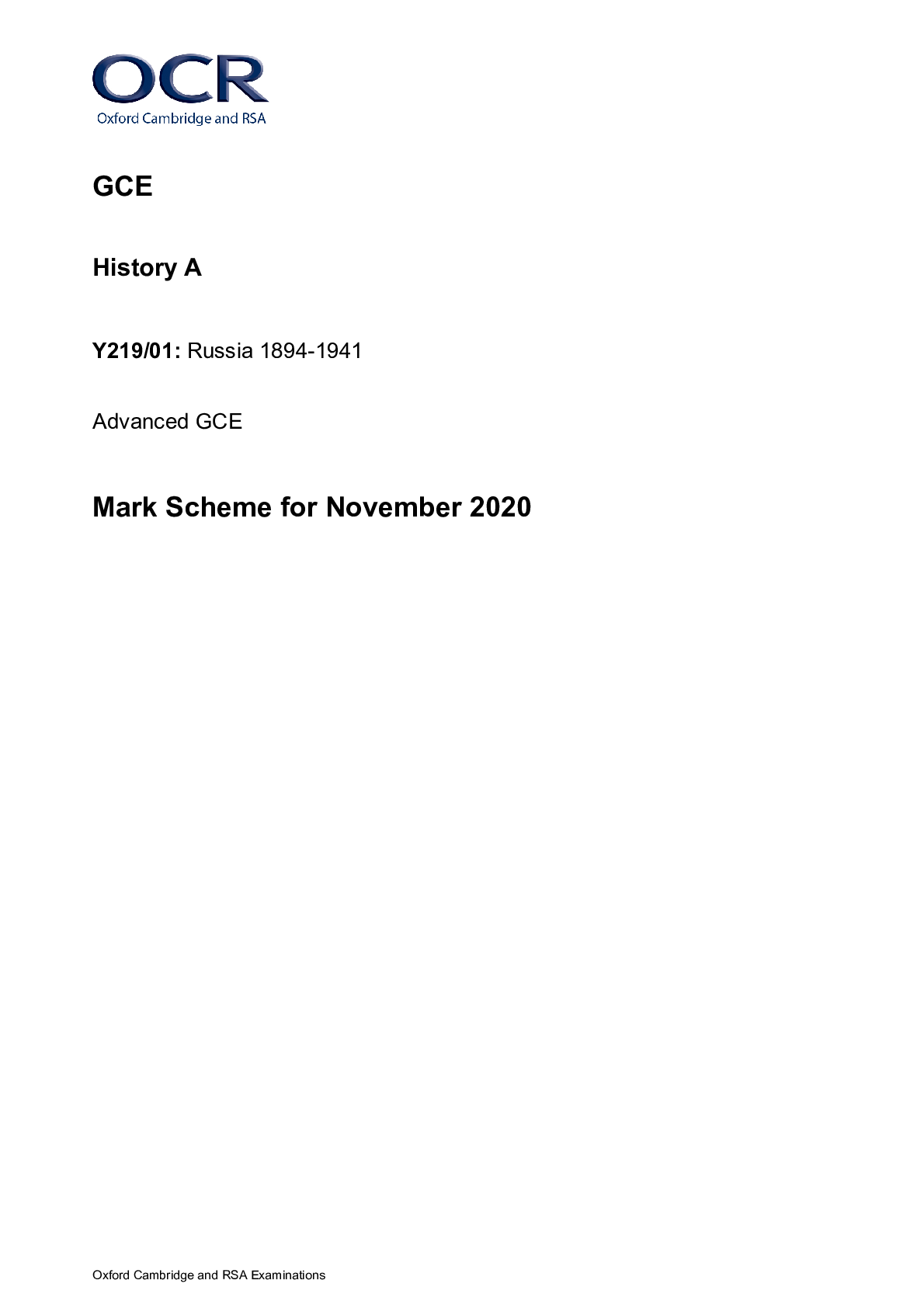
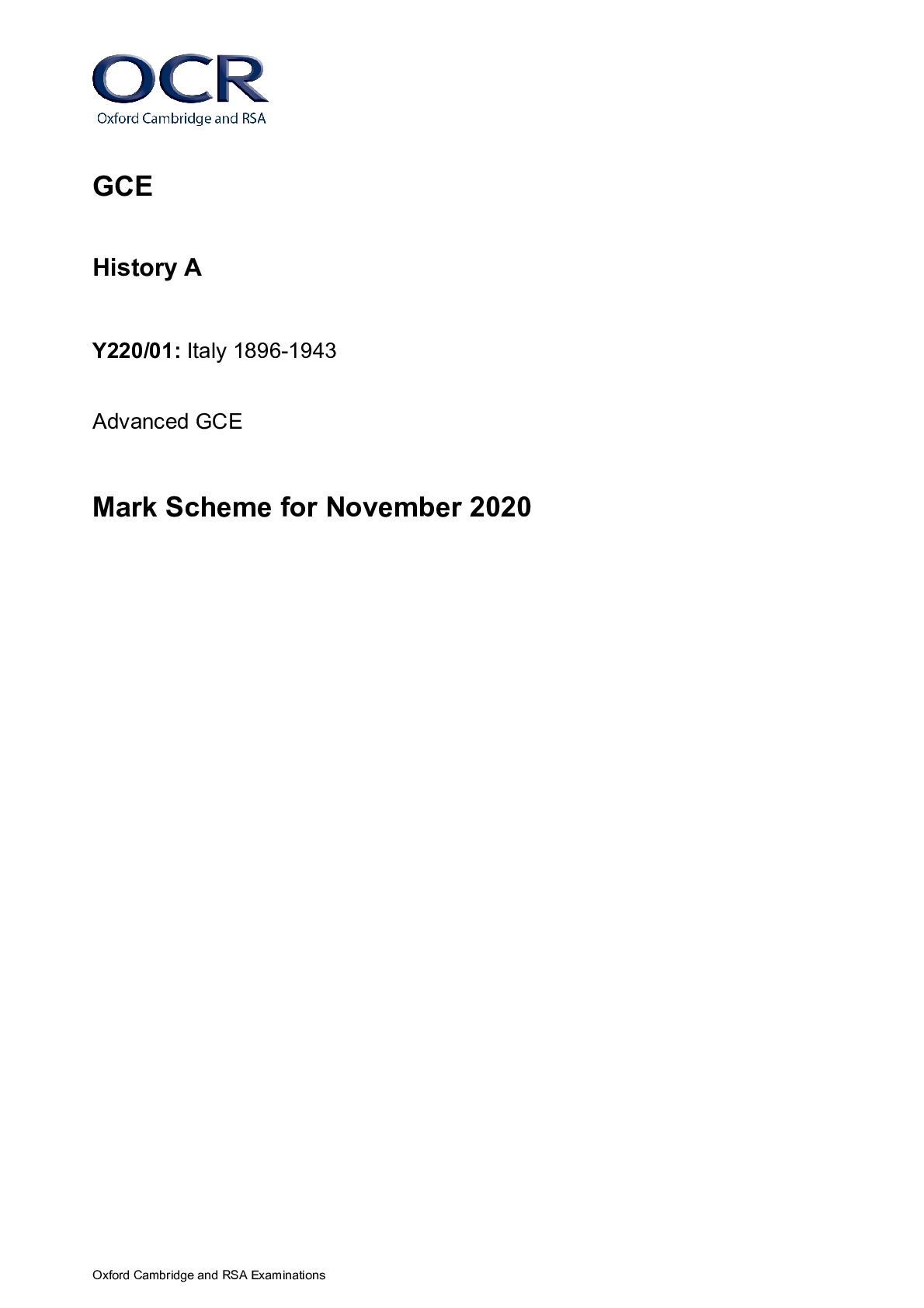

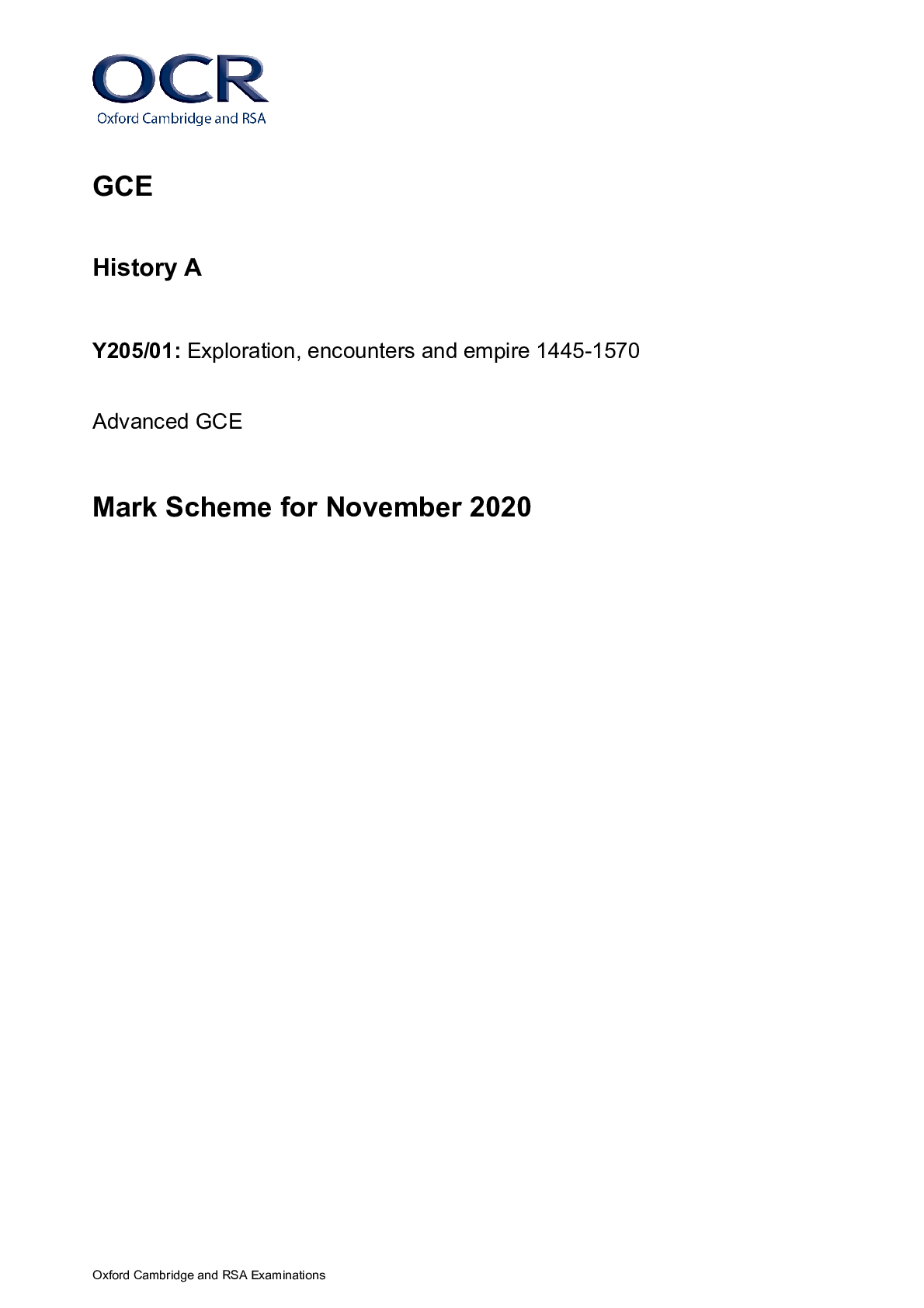
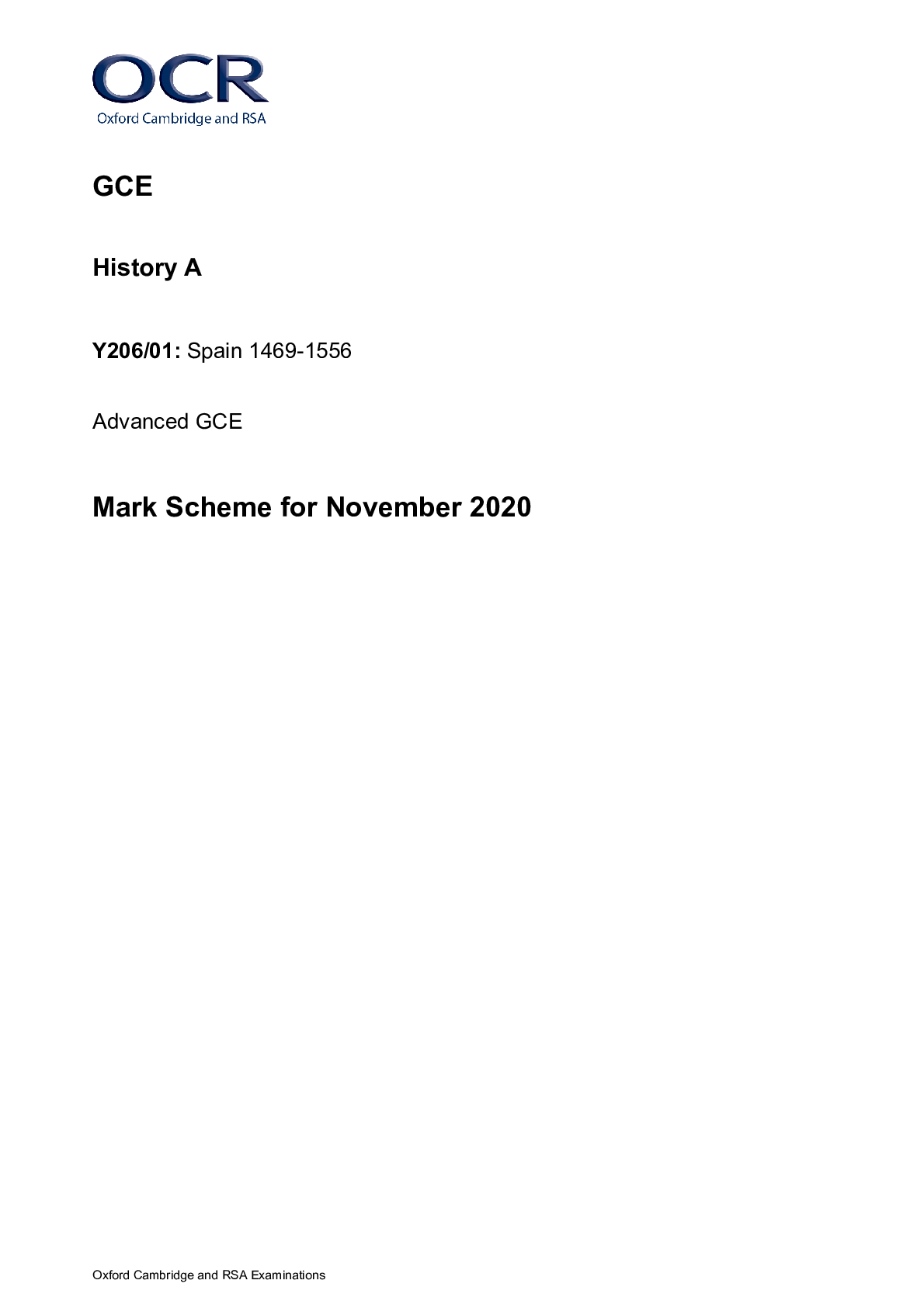
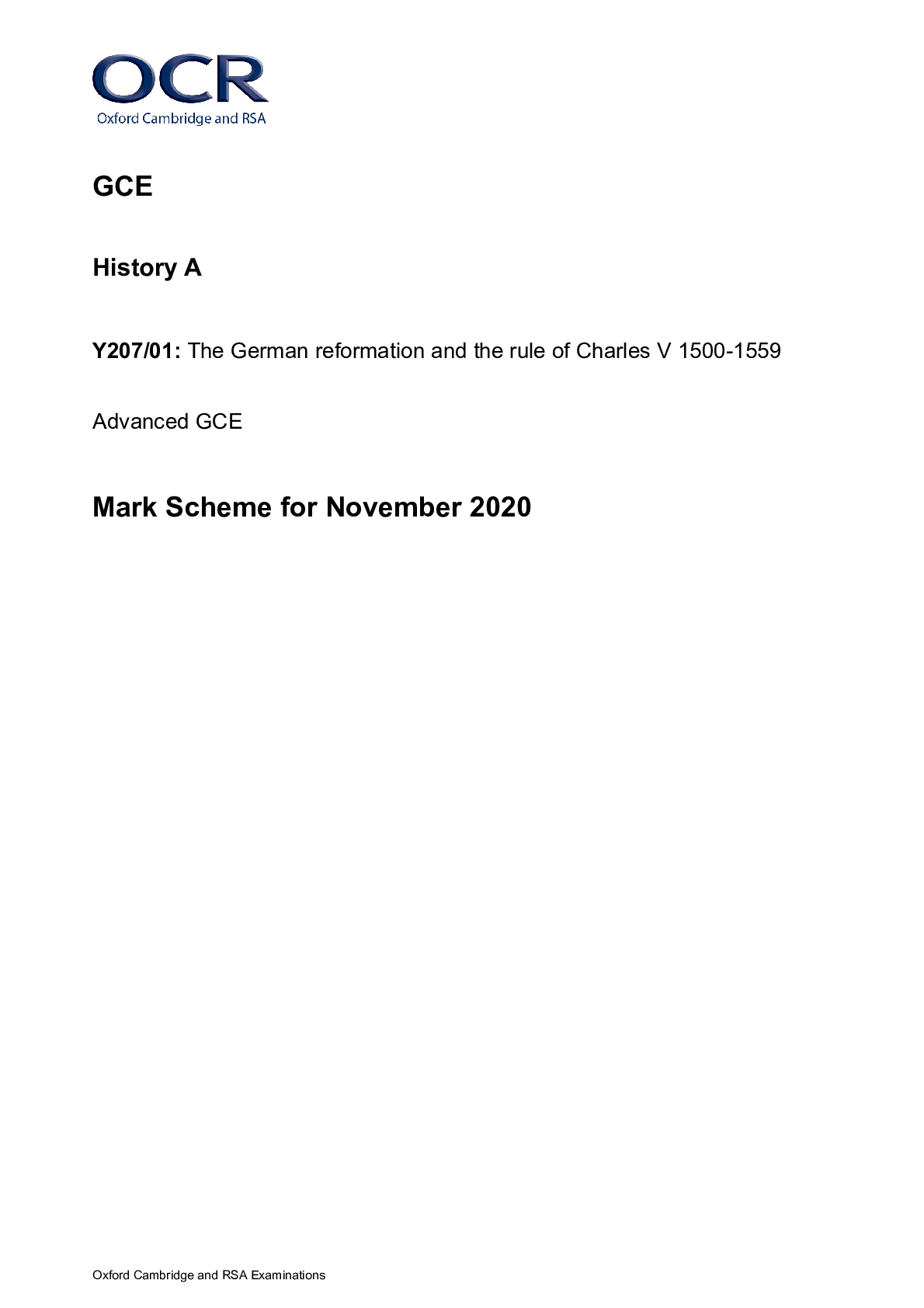
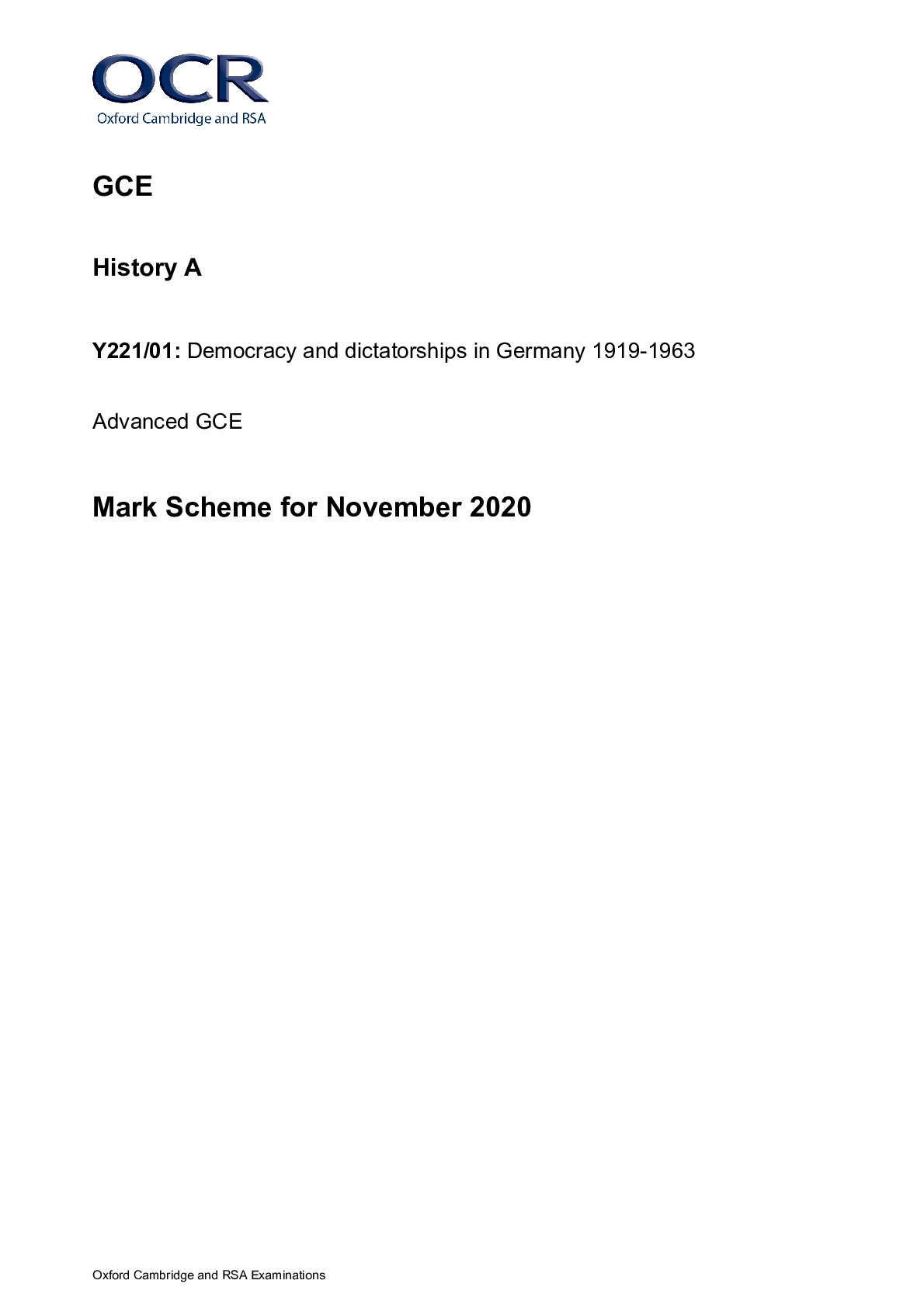

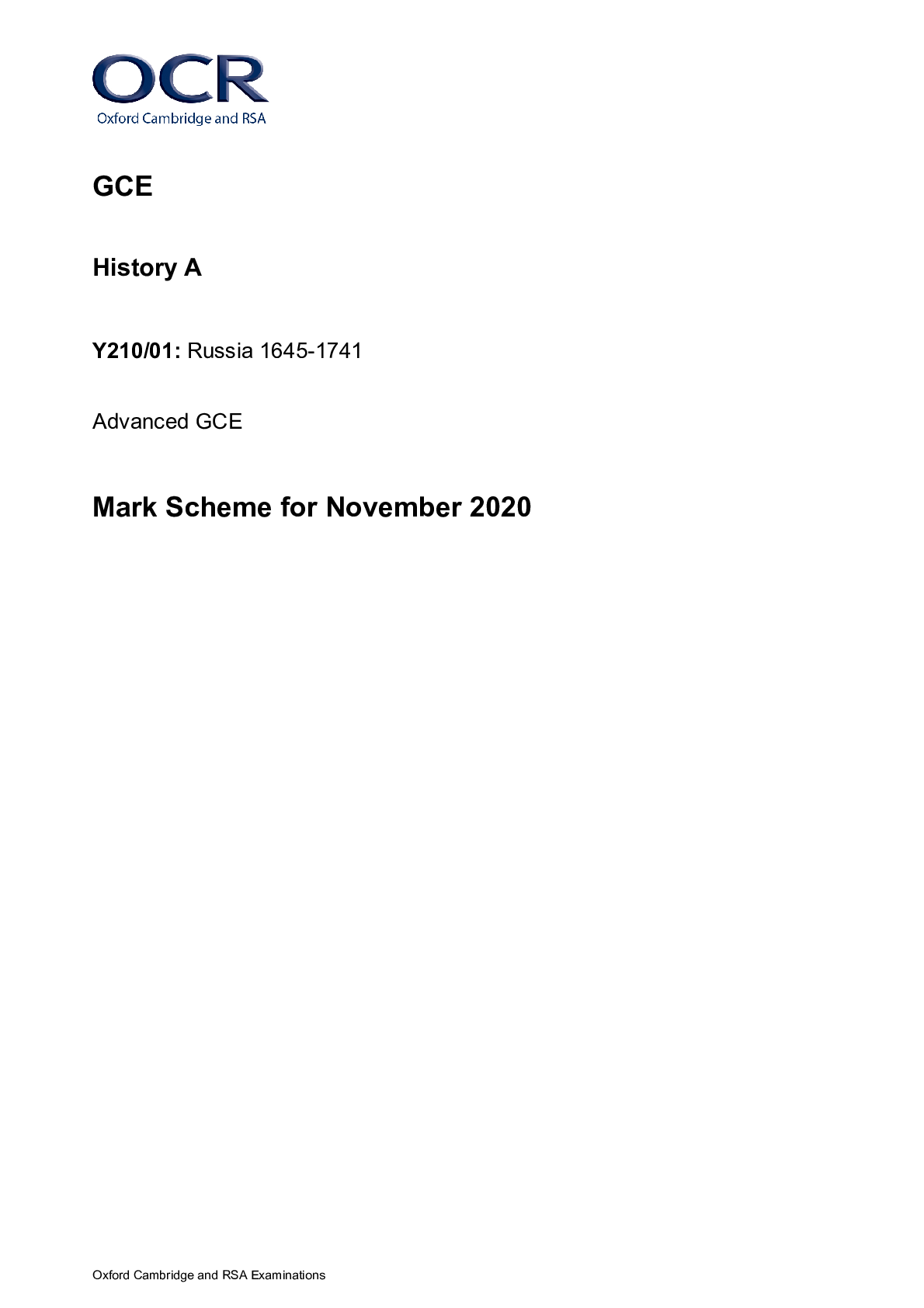
.png)


